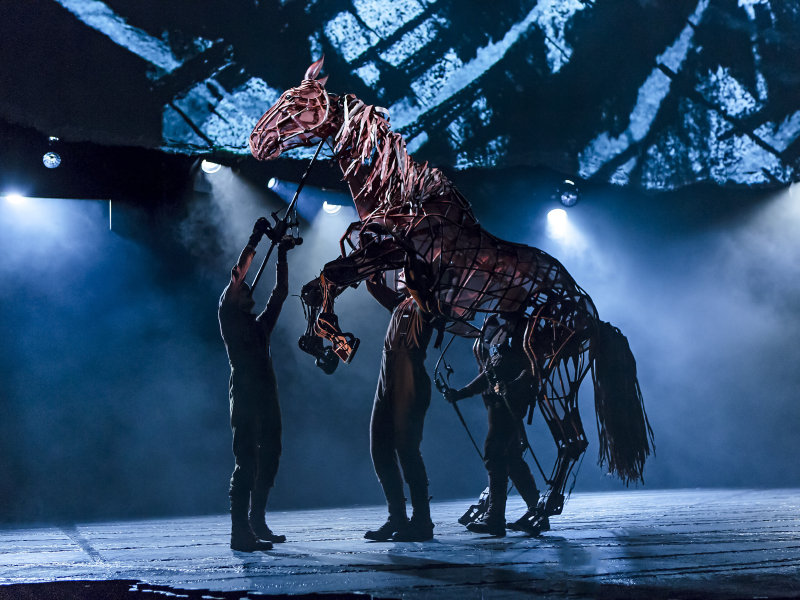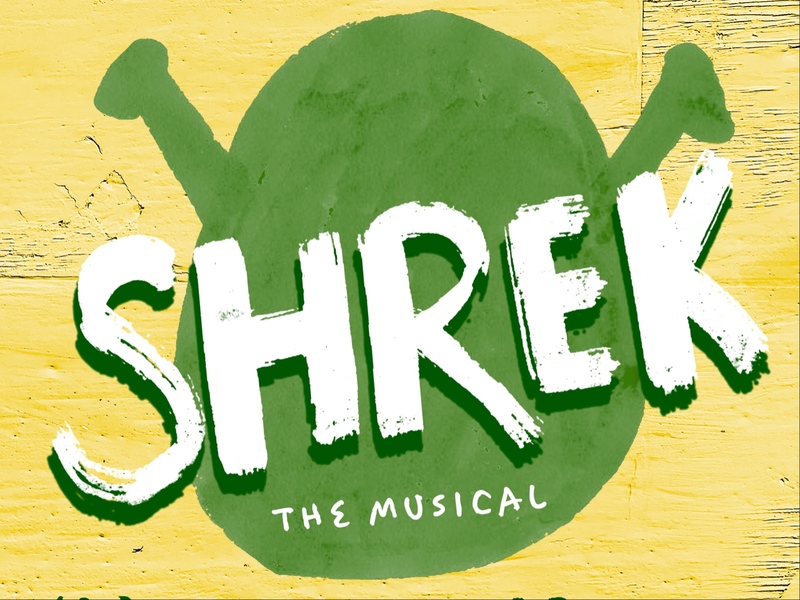One of the classic cardinal rules of theater is you don’t work with animals or children. Following that commandment, "War Horse" – a story of friendship between a young boy and his horse, Joey, caught in World War I – should be an impossible production.
However, the equestrian-led show has not only been produced, but it’s thrived thanks to the three-person puppet crew that brings the titular war horse to life. As a result, it’s become a worldwide stage hit, as well as an Oscar-nominated Steven Spielberg movie of the same name. The touring production is now coming to the Marcus Center for a six-day run, starting Jan. 7. Before the curtain goes up, OnMilwaukee talked with the talented puppeteers tasked with giving their puppet – and therefore the play – a lifelike pulse.
OnMilwaukee.com: What were your first thoughts when you read about the show and having a puppeteered horse on stage? Because I imagine that’s gotta be a weird role to try out for.
Dayna Tietzen: (laughs) It is, and we work in a group of three, so even that in itself is sort of bizarre to most actors who are used to having their own freedom. I know for me, I watched a lot of the videos and got a sense of the horses they were creating. Obviously, these horses are pieces of art in their own right. They’re nothing like the kind of pantomime horses you might imagine.
When I walked into the rehearsal space when I had my first audition, they had the horses hanging there, and really they’re pieces of art in their own right. It’s a pretty incredible honor actually to be able to get into them and start using them. And when you start actually looking like a horse, not like three people trying to move across a space, it’s really rewarding.
Danny Yoerges: The process of creating the character and learning the art of puppetry was the most rewarding and exciting thing. I mean, the object of what we do is to sort of fade into the background in a way, so for me, the excitement was in learning how to do that and do it very well.
Patrick Osteen: The audition process was different from anything I’d ever done before. It was this three-hour workshop. We’d go in and, as Dayna was saying, they had the horse there in the room. We’d go through a series of different exercises.
Ultimately, they’d just start taking people and throwing us into the horse and letting us have at it, being as messy as we need to be and learning how to do this thing together. It was full camaraderie. It was very cool how it brought people together in that way of really needing each other to make this thing work.
OMC: Was it intimidating for you, as someone who doesn’t have a lot of puppeteering experience, to hop into this?
PO: When I first went in the room, I think the fact that I didn’t have any puppetry experience sort of allowed me to not have any precursors and just jump headlong into it. To be honest, when we got the job and we sat down, the first thing that Adrian (Kohler) and Basil (Jones) did as our puppetry directors was basically take us through their principles of puppetry. So all of the people, no matter what their background, got inundated with the basics.
OMC: What are some of those foundational elements that they taught you?
PO: One would be micro-movements. They trained us that, if we use very specific movements that are small and don’t get static-y with a bunch of other things going on, it’s a much clearer story. There are things like that. There’s things like "passing the ball," which is when I make an action toward another character on stage, there’s an offering and then you allow the other person to take what you’re offering and have their own moment. So, in that way, we pass the ball back and forth so there’s not so much physical dialogue happening all at once, especially with puppets.
OMC: You guys have been talking about making a character out of this horse with three people. How do you do that?
DT: We each work in our own position in the horse, and quite technically, we end up using different parts of the puppet to communicate how our character of Joey is reacting.
Danny is able to move the head and the neck, and we have these really great eyes in the puppet that sort of catch the light so you really get a sense of what the horse is looking at. The ears have full movement that really brings life to the puppet and makes it incredibly realistic, and you can tell by the ears how they’re feeling and what they’re looking at.
Patrick controls the breath of the animal. There’s a breath that the character has that all three of us follow, and it allows us to determine how three of us are feeling but also feeds into how the actual character is feeling. It also allows us to make all of the sounds that we make. We work as three people to create horse sounds – whinnies, snorts, screams.
And then back to me, I sort of hold up the back of the horse and give the real power of the hind legs into the gallops and the movements that we make. I also control the tail, which is another emotional indicator to give a sense of what the horse is feeling.
OMC: How do you guys train to have three people create a single character like that?
DT: Practice. (laughs)
DY: From the very beginning, the most important thing was that, when we got into the horse, we treated it like it was a performance in a lot of regards. Even in a room where we were just learning how to do it, we wouldn’t say to each other, "Hey, let’s go this way; let’s go that way." Eventually, we got to the point where we could say those things and not really affect our sense of suspension of disbelief. But the more we attempted to communicate non-verbally with each other from the beginning, the easier it became over time, and the horse became more and more lifelike.
DT: We’re now at a point where I’m not even conscious of who’s making what decisions. A lot of things happen sort of seamlessly without really making a decision about whether or not I think that’s what we should do. It’s a pretty cool process.
OMC: I’m assuming you guys do very little facial emoting on stage. Is that true?
DT: Patrick and I are inside of the horse where there’s sort of a mesh covering. By no means are we trying to hide the puppeteers. You can see us. You choose to look at us if you want to. But there’s a suggestion of horse skin, and we tend to blend in faster just by where we are.
Danny, though, is on the outside of the horse, and what we try to do – with the other puppets in the show as well – is try to give focus to the puppets. So if you see somebody operating the head of the horse, they’re always looking at the head of the horse itself. So whenever you might be curious or drawn to look at Danny, you’re immediately following his eyes back to the horse.
DY: From my perspective, there definitely is a sense of like, "Oh man, everybody can totally see me right now, and I’d prefer to that they’d not." It’s funny; when we first started rehearsing, Basil said ideally, as a puppeteer, you do not wear the facial expression of the emotion of your character on your face. But at the same time, he said he can’t help himself from doing that when he himself puppeteers. It’s just one of those things.
If the horse is really upset about something, it’s gonna show up on your face a little bit. You just have to check in with that and be as neutral as you can.
OMC: Why do you think that this show has captured so many people, both the play and the movie adaptation from a few years back?
PO: First off, I think the story itself is an extremely powerful story about basic human things, like trust and friendship and loyalty. The few characters – the horse and this boy – go on this journey of growing up together and what the world is becoming through the transition of World War I, which is this very new kind of war.
And I think that people identify with animals in a very specific, unique and personal way. This stage production really personalizes that experience for the audience. As Dayna and Danny were saying, we’re not trying to hide these puppeteers. You’re looking at this horse that is very clearly puppeteered by these three people, and it’s sort of a hint of a horse rather than being the most horse-like puppet they could make. There's this opportunity for the audience to fill in the blanks a little bit. They sort of have a part with their imagination in what they’re seeing.
So all of a sudden Joey, this creature walking around on stage, becomes a very personal character for each audience member because they make that journey individually.
DY: Without being weighty in any way, it’s also a war anthem for peace. People who have interest in history, but also just as sort of a connection to the world we live in now and what war means to everybody today, will come away feeling like they’ve connected to an important national sentiment. I think that’s true of the entire world.
As much as it is a gigantic cliché to say that one has always had a passion for film, Matt Mueller has always had a passion for film. Whether it was bringing in the latest movie reviews for his first grade show-and-tell or writing film reviews for the St. Norbert College Times as a high school student, Matt is way too obsessed with movies for his own good.
When he's not writing about the latest blockbuster or talking much too glowingly about "Piranha 3D," Matt can probably be found watching literally any sport (minus cricket) or working at - get this - a local movie theater. Or watching a movie. Yeah, he's probably watching a movie.







